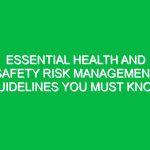“`html
Essential Mental Health Awareness Guidelines for a Safer Workplace
Introduction
Good morning team! Today, we’re going to discuss a crucial aspect of our workplace environment: mental health awareness. As we navigate through our daily tasks, it’s vital to remember that mental well-being is just as important as physical Safety. Understanding and promoting mental health in our workplace can lead to a safer, more productive environment for everyone.
Why is this topic important? Because mental health issues can significantly affect our performance, relationships, and overall job satisfaction. By recognizing and addressing mental health challenges, we can create a supportive atmosphere where everyone feels valued and understood.
Understanding Mental Health Awareness
Mental health awareness refers to the understanding and acknowledgment of mental health conditions and the impact they can have on individuals. It’s about recognizing that mental well-being is a critical component of our overall health, influencing how we think, feel, and act in our daily lives.
In the workplace, mental health awareness plays a significant role in fostering an environment where employees feel safe to express their concerns and seek help when needed. Common misconceptions are that mental health issues only affect a small number of people or that they are a sign of weakness. In reality, mental health conditions can affect anyone, regardless of their background or job role.
Key Hazards, Risks, and Safety Considerations
Ignoring mental health in the workplace can lead to several Hazards and risks, including:
- Increased absenteeism: Employees struggling with mental health may take more sick days, disrupting team productivity.
- Decreased productivity: Mental health issues can impair concentration, decision-making, and overall job performance.
- Higher turnover rates: A lack of support can lead to employees leaving the company, which can increase recruitment and Training costs.
- Workplace conflicts: Stress and anxiety can lead to misunderstandings and conflicts among team members.
Real-world consequences of neglecting mental health can be severe. For example, a study found that employees with untreated mental health issues experience a 35% reduction in productivity. This not only affects individual workers but can also have a ripple effect on the entire organization.
Best Practices, Procedures, & Actionable Advice
So, what can we do to promote mental health awareness in our workplace? Here are some Best Practices:
- Encourage open communication: Create an environment where employees feel safe discussing their mental health concerns. Regular check-ins and an open-door policy can help.
- Provide training: Offer training sessions on mental health awareness for all employees. This can help reduce stigma and educate everyone on recognizing signs of distress.
- Implement supportive policies: Develop workplace policies that support mental health, such as flexible working hours or mental health days.
- Promote work-life balance: Encourage employees to take breaks, use their vacation time, and disconnect from work after hours.
Here’s a real-life example: A company noticed rising stress levels among employees. They implemented weekly wellness workshops focusing on stress management and mindfulness techniques. As a result, they saw a 20% decrease in reported stress levels and improved team morale.
Regulations, Standards, and Compliance
It’s essential to understand that mental health awareness is not just a best practice; it’s also a legal obligation in many regions. Regulations such as the Occupational Safety and Health Administration (OSHA) guidelines outline the importance of mental well-being as part of overall Workplace Safety. Compliance with these Standards not only protects employees but also mitigates risks for the organization.
By adhering to these Regulations, companies can cultivate an environment that prioritizes employee mental health, ultimately leading to higher productivity and job satisfaction.
Employee Engagement & Discussion
Now, I’d like to open the floor for discussion. What are some challenges you’ve encountered regarding mental health in the workplace? Have you noticed any signs of distress in yourself or your colleagues? Sharing experiences can help us learn from one another and foster a more supportive environment.
Also, consider how you can contribute to mental health awareness. Whether it’s checking in on a colleague or participating in mental health training, every action counts.
Conclusion & Key Takeaways
In conclusion, mental health awareness is a vital aspect of creating a safer workplace. By recognizing the importance of mental well-being, identifying risks, and implementing Best Practices, we can foster a supportive environment for all employees.
Remember, mental health is just as important as physical health. Let’s prioritize it in our daily operations and support each other in building a healthier workplace. Thank you all for your attention and commitment to safety!
“`


